At dawn on 6 June 1944, more than 160,000 Allied troops from all over the world landed on five heavily defended Normandy beaches. It was the beginning of Operation Overlord, the invasion of north-western Europe that would ultimately end in the liberation of France and the defeat of Nazi Germany.
Today, as you walk along the same sandy shores, it can be difficult to imagine the scenes of terrible and chaotic conflict which unfolded here. But reminders are everywhere. From abandoned sea defences to gun emplacements, memorials to war graves, Normandy will never forget the sacrifices that were made for freedom.
Many people every year come to pay their respects to the fallen. National military cemeteries can be found all over Normandy, and there are more memorials tucked away amongst the dunes, villages and towns of this beautiful part of northern France.
This article includes tips for visiting the key beaches on the Normandy coast which were involved in the D-Day landings, as well as other wartime places of interest, all of which are within a short drive from the LeShuttle terminal in Calais.
Why were the D-Day landings significant?
Seen by many as the beginning of the end of World War Two, the Normandy landings were one of the most daring and important military operations ever executed. Allied troops had to endure intense German artillery to fight their way off the beaches and secure a foothold in France. But by the end of June 1944 they had succeeded, and the landing force began to make their way slowly inland. Within a year Berlin fell, and victory in Europe had been won.
Why were the Normandy beaches selected for D-Day?
Normandy was chosen for the D-Day landings because it was in range of the fighter aircraft base in England. The beaches were also more open and less well defended compared to those in the Pas de Calais. The Cherbourg port in Normandy is also opposite one of the main ports on the English South Coast and was large enough to accommodate some of the ships in the Allied invasion force.
What is happening to mark the 80th anniversary of D-Day?
June 2024 marks the 80th anniversary of the D-Day landings, and special events are taking place across Normandy in commemoration.
The official international ceremony
Heads of state, D-Day veterans, officials and specially invited guests will gather on Thursday 6th June at Omaha Beach for a ceremony of remembrance. Access to the beach on the day of the anniversary will be tightly restricted, and this will be an event broadcast to millions around the world.
D-Day Festival Normandy
The D-Day festival in Normandy is an annual event, but in 2024 it promises to be even more special. Festive and cultural events will take place across the Normandy coastline between 1-16 June. Activities include parades, concerts, historical re-enactments, firework displays and exhibitions.
Standing with Giants installation
Many people will remember the first Standing with Giants installation, in Oxfordshire in 2019. The team behind the incredibly moving silhouette soldiers will mark the 80th anniversary of D-Day by erecting 1,475 figures at the British Normandy memorial at Ver-sur-Mer, near the site of Gold Beach. The number of figures represents the amount of British fatalities on D-Day, and the installation will remain in place throughout the summer of 2024.
The Normandy D-Day beaches
The Allies selected five strategic points along the Normandy coast to land their invading forces, each with its own codename: Sword, Omaha, Gold, Utah and Juno.
Sword Beach
Where in France: Saint-Aubin-sur-Mer to Ouistreham
Drive from Calais: 359.1km / 3h 35m
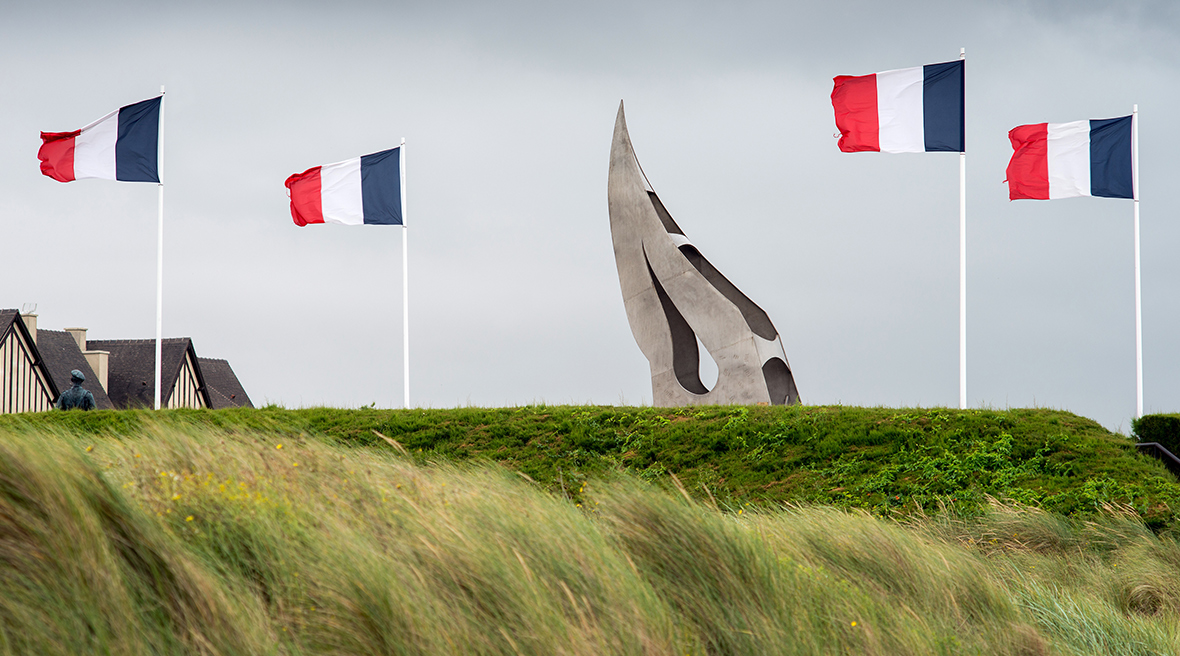
The Flame Monument at Sword beach
The furthest east of these beaches was codenamed Sword Beach, an 8km stretch of coast from Ouistreham to Saint-Aubin-sur-Mer.
The initial landings, backed up by early morning air strikes, were some of the most successful in terms of minimising casualties, with very little resistance encountered on the beach itself. British troops took only 45 minutes to move inland, and by the end of the day nearly 29,000 men had been successfully landed at the beach.
Many of the German defences are still visible on these picturesque beaches and signs of the conflict can be found scattered around the charming villages which line this stretch of Normandy coast. In the port town of Ouistreham visitors can find the small but informative Musée du Débarquement no 4 Commando, which attempts to explore the human faces behind the invasion and the important legacy of the D-Day landings.
Today the town's beach is popular with tourists and locals alike as a spot for sun-bathing, relaxing or beach sports, including horse riding through the surf. But you are never far from a reminder of those who laid down their lives to make France the free country it is today.
Omaha Beach
Where in France: Sainte-Honorine-des-Pertes, Saint-Laurent-sur-Mer and Vierville-sur-Mer
Drive from Calais: 393.8km / 3h 47m
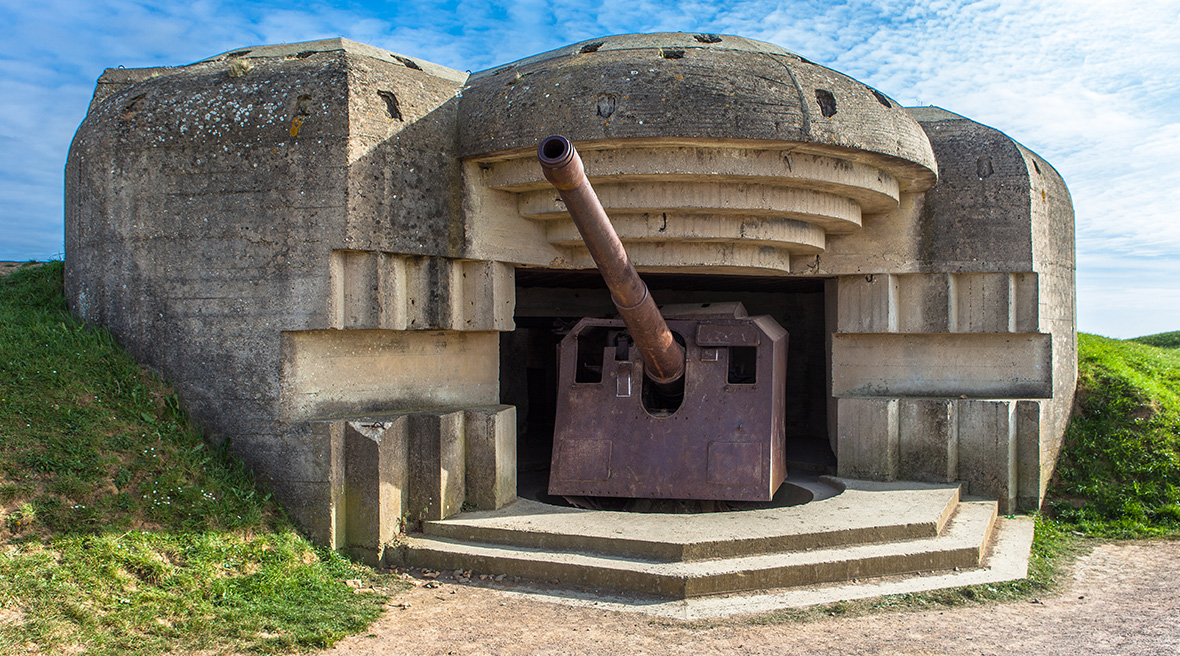
Gun emplacement at Omaha Beach
Probably one of the most famous sectors of the D-Day operation, Omaha beach was the landing spot for more than 40,000 American troops who waded through the surf to face a barrage of German mortars, machine guns and artillery. Despite preliminary naval and aerial bombardment of the beach defences, very few gaps were opened up and the invading army quickly found itself incurring huge casualties. As many as 5,000 Allied soldiers are estimated to have been killed within hours of the landing.
The fighting on the beaches was recreated on screen in the dramatic and bloody opening scenes of Steven Spielberg war epic Saving Private Ryan, which won praise for its historical accuracy.
Today Omaha beach has become a pilgrimage spot for families and veterans remembering the conflict and those who were lost in the line of duty. Walking across the golden sands or exploring the cliff-tops swarming with natural beauty, it can be difficult to picture the scenes of chaos and bloodshed which unfolded there. However, there are reminders everywhere of the beach's historical significance and visitors can explore abandoned concrete bunkers and gun placements and even see the craters left by falling shells which scar this otherwise idyllic coastline.
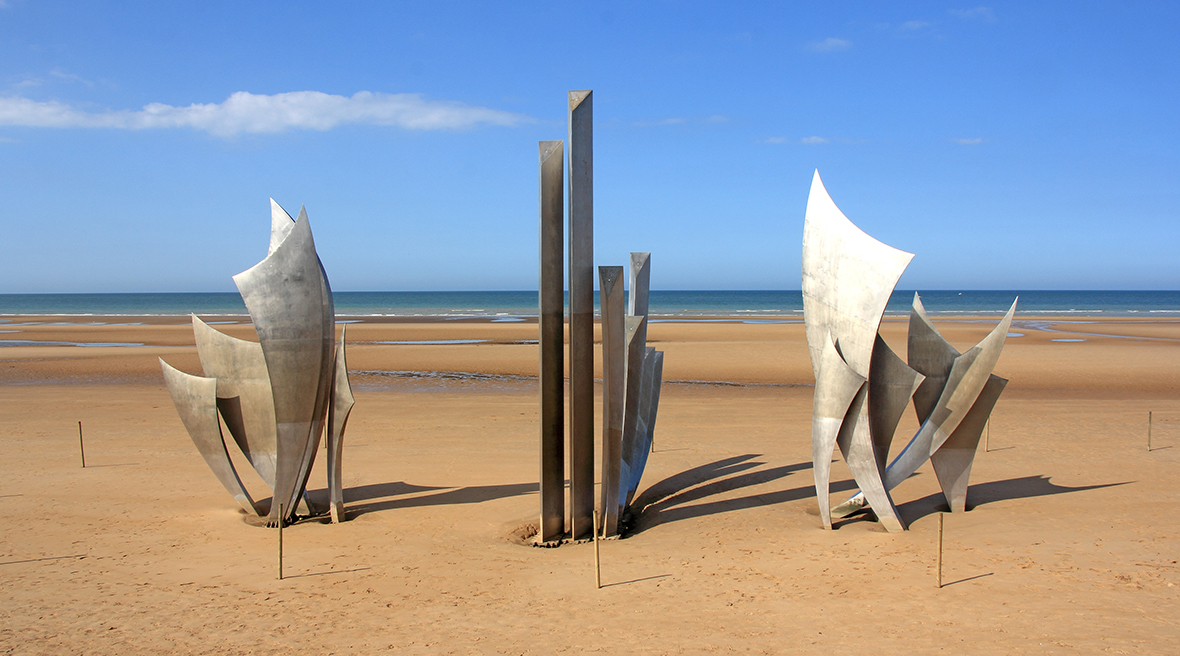
The striking Omaha Beach Memorial
Omaha Beach Memorial
Particularly striking is the Omaha Beach Memorial, marked by a conceptual statue of giant metallic sword shapes bursting up through the surf. Here you can find a museum featuring comprehensive details of the D-Day landings, with artefacts, timelines and personal items from those involved in the fighting, helping visitors understand the human side of the conflict.
Normandy American Cemetery and Memorial
Where in France: Colleville-sur-Mer
Drive from Calais: 391.7km / 3h 51m
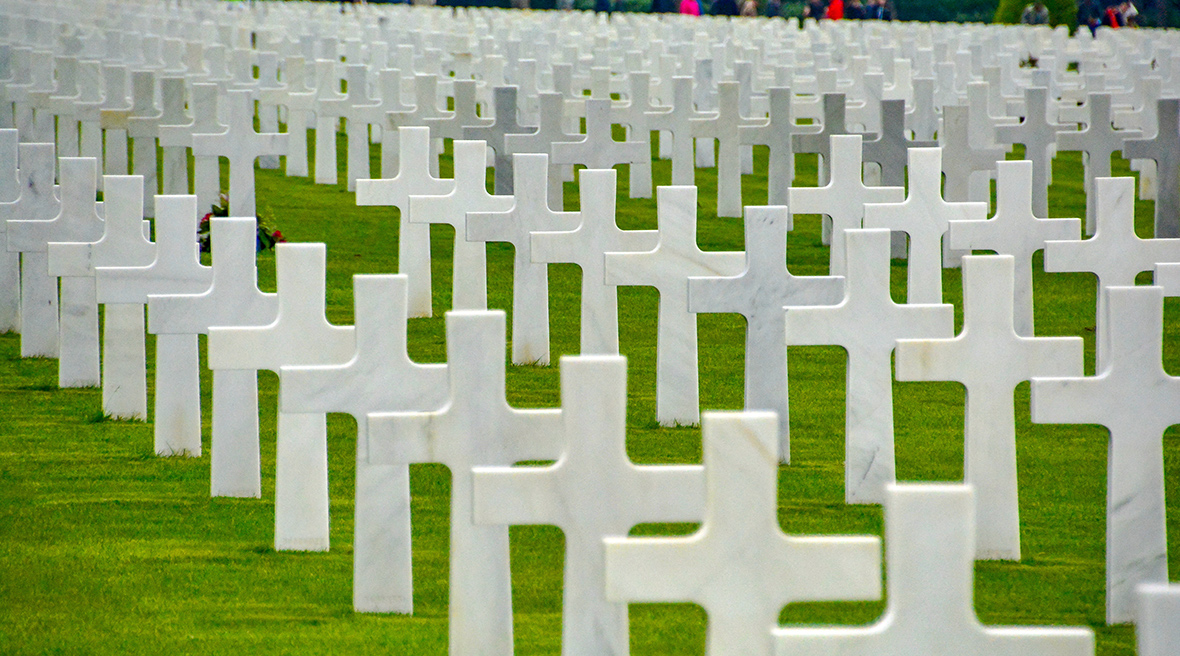
A cemetery and memorial for American soldiers overlooks Omaha beach
On the cliff tops overlooking Omaha beach can be found the final resting place of thousands of American soldiers who lost their lives in the D-Day landings and ensuing fighting. The rows of individual white headstones serve as a poignant reminder of the sheer number of casualties and regular tours around the cemetery give you some of the stories behind the graves.
Gold Beach
Where in France: Arromanches-les-Bains, Le Hamel, and La Rivière
Drive from Calais: 398.4km / 3h 43m
Stretching between Le Hamel and Ver sur Mer, this landing spot saw some of the fiercest British beach fighting, with the invading troops facing heavy German resistance. The spot was also where Company Sergeant Major Stanley Hollis earned the only Victoria Cross of the D-Day landings after single-handedly storming two enemy pill boxes and later saving two of his comrades who had been pinned down by enemy fire.
Sea defences and even a gun placement can still be explored by visitors to the beach front by Ver sur Mer and a simple memorial plaque stands at the top of the beach paying respect to those who fought there.
Utah Beach
Where in France: Quinéville to Sainte-Marie-du-Mont
Drive from Calais: 415 km / 4h 15m
The westernmost D-Day beach, Utah is located between the villages of Quinéville and Sainte-Marie-du-Mont on the Cotentin Peninsula. Utah saw the fewest number of casualties – only 123 men were lost of the 23,000 US 1st Army troops who stormed the beach in the early morning of June 6th. Today visitors can experience the story of the assault on Utah in the Museum of the Landings, which includes a film, Victory in the Sand, the display of a B 26 bomber plane and a collection of objects, vehicles and materials.
 D-Day memorial at Utah Beach
D-Day memorial at Utah Beach
Juno Beach
Where in France: Courseulles-sur-Mer
Drive from Calais: 361 km / 3h 38m
The six-mile sweep of Juno beach either side of the pretty fishing village of Courseulles-sur-Mer was a scene of carnage and confusion on D-Day. The majority of the soldiers stepping onto Juno that day were from the Canadian 3rd Infantry. Their landing was delayed by stormy seas and a high tide, giving German artillery more time to prepare; the invasion force also had to breach an imposing sea wall. If it had not been for the arrival of Canadian amphibious tanks the Allied casualty figure of 1,200 would have been far greater.
The Juno Beach Centre explores the contribution made by Canada to World War II. The various memorials across the beach include the British tank that was abandoned on D-Day and which remained buried on the beach for 32 years.
Bayeux War Cemetery
Where in France: Bayeux, Calvados
Drive from Calais: 376.5km / 3h 35m
A little inland can be found the Bayeux Commonwealth War Graves Commission Cemetery, which commemorates more than 4,500 Commonwealth troops, most of whom died in the Normandy landings. The graves include more than 1,800 unknown soldiers, a moving testament to the chaos of war.
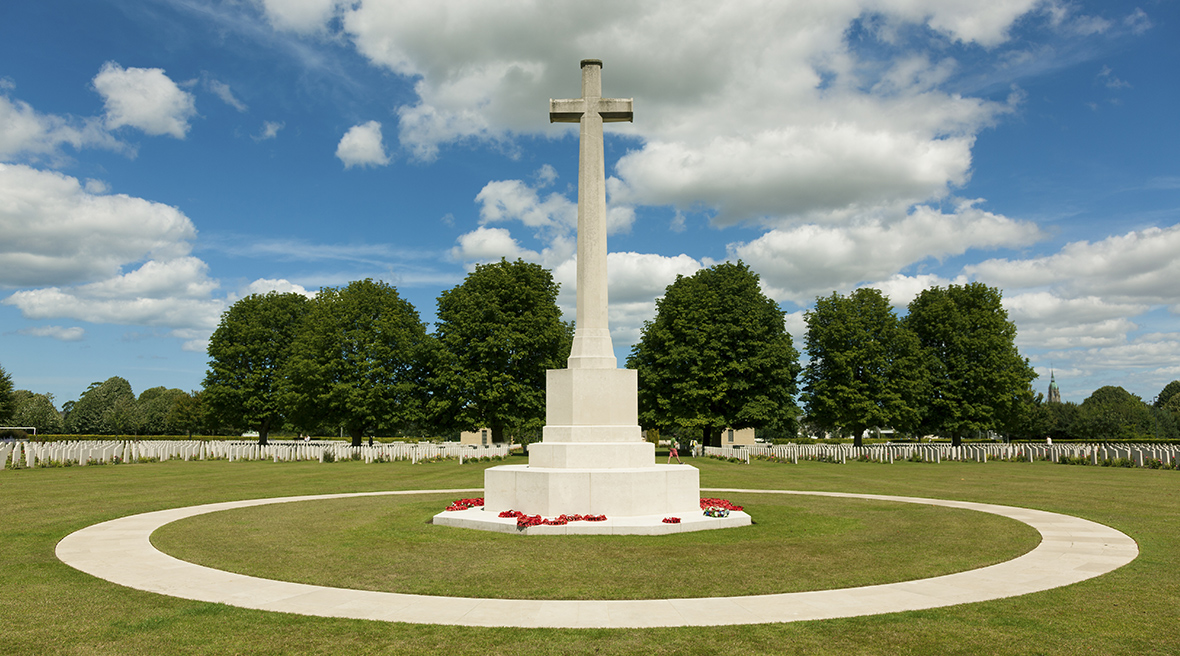
The British cemetery in Bayeux is the largest Second World War cemetery of Commonwealth soldiers in France.
British Normandy Memorial
Where in France: Ver-sur-Mer
Drive from Calais: 367 km / 3h 50m
Opened in 2021, this is the first national memorial in Normandy dedicated to the forces under British command who lost their lives on D-Day and during the subsequent Battle of Normandy. The 50-acre site at Ver-sur-Mer is close to Gold beach, and records the names of 22,442 servicemen and women, along with a French memorial for the local civilians who also died. Even if you have no personal connection with a D-Day veteran, visiting the British Normandy Memorial is an incredibly moving and humbling experience.
Driving to Normandy to see the D-Day beaches
The Normandy invasions were one of the most important and daring military operations in world history, and a trip to the D-Day landing beaches can give a small glimpse into how events unfolded and the bravery of all involved.
From the LeShuttle terminal at Calais drive west along the coast into Normandy. Follow the A16 and change onto A29, before finally joining the A13 for the remainder of your journey. This route includes toll roads, so another option would be to take the scenic route along D940 and the following D-roads, which will take longer but takes in towns such as Wimereux and Le Touquet and avoids tolls.
Feeling inspired to discover the history of the Second World War? It’s only a 35-minute crossing from Folkestone to Calais. Book your trip with LeShuttle.